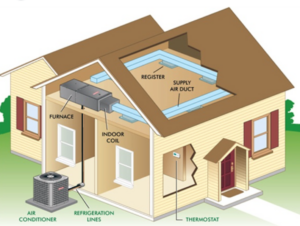How to find which Air Conditioning Unit is right for you.
Air conditioning is a modern-day necessity that has become an integral part of our lives, especially in hot and humid climates. It provides comfort, reduces indoor air pollution and helps maintain a healthy indoor environment & air flow. But with so many different types of air conditioners available in the market, it can be difficult to choose the right one for your home or office. In this article, we’ll discuss the different types of air conditioners and their features to help you make an informed decision. Let’s Ask the JJ&A Mechanical Technician Owner and Operator Justin Ralph.
“There are four main categories of Air Conditioners I will break down below, each of them built to provide cooling under different circumstances specific to your home. Reading about each one here along with looking at the diagrams should give you a better idea of which system is right for you. If you still have question, feel free to utilize our live chat option and we will get back to you as soon as we can!
- Window/Portable Air Conditioners – Window air conditioners are a great option if installing an air conditioning system is not in the budget right now. They generally do not require a professional to install, are easy to operate and are easily removed. However, they can be noisy, are a bit of an eye sore and can obstruct the view from the window. Their life expectancy is generally not very long either.
- Central Air Conditioning – Central air conditioning is best option in my opinion but if your home does not utilize a furnace and duct work to heat your home then unfortunately it is not an option for you. It utilizes an outdoor unit and an indoor coil that is installed on top of your furnace. It uses your existing duct work and furnace to provide cooling throughout the house. It is relatively inexpensive in comparison to a ductless system and requires professional installation, but it provides the highest level of comfort and can save energy in the long run. This system can be installed with an air conditioner which only does cooling or a heat pump which does cooling and heating.
- Ductless Mini-Split Heat Pumps – Ductless mini-split systems do both heating and cooling. They utilize an outdoor unit and a small indoor unit that doesn’t require ductwork. They are ideal for homes that don’t have the necessary ductwork for central air conditioning. These systems are generally more expensive then central air conditioning because you require an indoor unit for every room/area that you want air conditioning in as apposed to central where you only require one indoor coil to be installed on top of your furnace. To conclude: If you do not have a furnace then the ductless system is generally your most cost effective and least destructive option (unless you have an attic and you live in a rancher or do not require your entire house to have air conditioning. If this is you, read below!)
- Air Handler Ducted Through Attic To Each Room & Outdoor Air Conditioner or Heat Pump – The reason people generally choose a ductless system over installing a ducted air conditioning system is because to install ducts throughout your home requires a lot of drywall damage which leads to additional costs associated with the installation above and beyond the install itself. Drywall repair, mudding, taping, and painting adds up quickly especially when you just paid for a brand new air conditioning or heat pump system. If you live in a single level rancher or if you live in a multi-level home but are only concerned about providing cooling to the top floor then installing this system in your attic is perfect. Its perfect because you wont need to do any repairs when were done which is always our goal. We simple install the air handler in the attic, run sheet metal supply duct work to each room you want to have cooling for and then run a line set from the outdoor unit to the air handler. This option is generally cheaper than going with a ductless split system that requires more than 3 heads. The only negative in comparison to a ductless system is that with this system you only get one temperature control. This means that if you put the thermostat in the master bedroom then that thermostat decides the temperature for every room. Meaning if you’re in the master bedroom and you want air conditioning to be on but the person in one of the guest bedrooms, kitchen or living room wants it off then its too bad for the people in those other rooms. Master bedroom would be in charge. To conclude: If you do not have a furnace, you have an attic and are okay with not having the luxury of being capable of setting each room at a different temperature than this is a great option for you.



